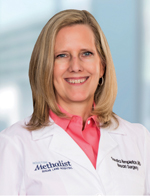Posted on Oct 2, 2022 in
FOCUS ON THE CURE

When life is busy, it’s easy to put everyone else’s needs before your own. But it’s important to make time for yourself — and your annual screening mammogram. If you’re not sure when to start getting mammograms or what to expect, we’re here to help.
Sandra Templeton, M.D., board-certified surgeon with Houston Methodist Breast Surgery Partners at Sugar Land, answered some common questions women have about getting mammograms.
Preparing For Your Mammogram

Sandra Templeton, M.D.
Houston Methodist Breast Surgery Partners in Sugar Land
When should I start getting screening mammograms and how often? Your doctor may recommend annual mammograms starting at age 40 if you have an average risk for breast cancer. Ask your doctor about your risk for breast cancer and the screening schedule that’s right for you.
Why should I get an annual mammogram? Getting regular mammograms makes it possible to detect breast cancers when they are small and easier to treat. It’s also helpful to be able to review your mammogram history and track any changes in the breast over time.
What do I need to know about scheduling my mammogram? It may be helpful to avoid scheduling a mammogram the week before your period, when breasts may be more tender. However, it’s important to get in for a mammogram whenever it works with your schedule.
What should I wear for my exam? Life is busy, and it’s okay if you show up as you are for your mammogram. Wearing a two-piece outfit makes it easier to remove your top for your mammogram, and it’s best to avoid wearing deodorant, powders or lotions. You’ll be offered wipes to remove deodorant, if needed.
Does my insurance cover a mammogram? Most major insurance plans cover an annual screening mammogram, but it’s important to call and verify your coverage.
Creating A Comfortable Experience
What happens during a screening mammogram? The technologist will ask you some questions related to your health, including birth control, family history of breast cancer and any symptoms you may be experiencing. These questions are important to help make sure we’re doing the right type of mammogram. Next, you’ll be asked to stand in front of a 3D mammography machine, and the technologist will take two different X-ray views of each breast.
Are mammograms painful? Some women may find the breast compression to be uncomfortable or painful, but the experience is different for everyone. The compression takes about 10 seconds for each image, and our technologists are trained to listen to you and make the experience as comfortable as possible.
Understanding Mammogram Technology
What is a 3D mammogram? A 3D mammogram, also called tomosynthesis, is the latest, most advanced technology to detect breast cancer with the greatest accuracy. 3D technology uses a low dose of radiation, yet allows for more targeted views that help find small cancers.
What is the purpose of a screening mammogram vs. diagnostic mammogram? A screening mammogram is done when you have no symptoms of breast cancer. The purpose is to find cancers in an early stage before you can feel a lump. If an irregularity on a screening mammogram is found, you may be asked to come back for further testing. A diagnostic mammogram may be ordered after a screening mammogram shows a questionable area, if you feel a lump in your breast or have other symptoms.
Getting Your Results
Who will review my images? Board-certified breast radiologists are specially trained to interpret breast mammogram results.
How will I get my results? Once reviewed by a doctor, you can view your results in the patient portal. The lead technologist will call you to share findings and schedule further testing, if needed.
What does it mean to have dense breast tissue on a mammogram? Density refers to how much fibrous tissue is in the breast. Having high density on a mammogram makes it more difficult to see a mass. In some cases, a breast ultrasound may be ordered in addition to a mammogram for women with high breast density.
What if I get called back for a second mammogram? Getting called for a second mammogram doesn’t mean you have cancer. It means more information is needed to see what’s going on. When you come in for a diagnostic mammogram, a breast radiologist will meet with you to share the results and answer your questions.


 <
<







